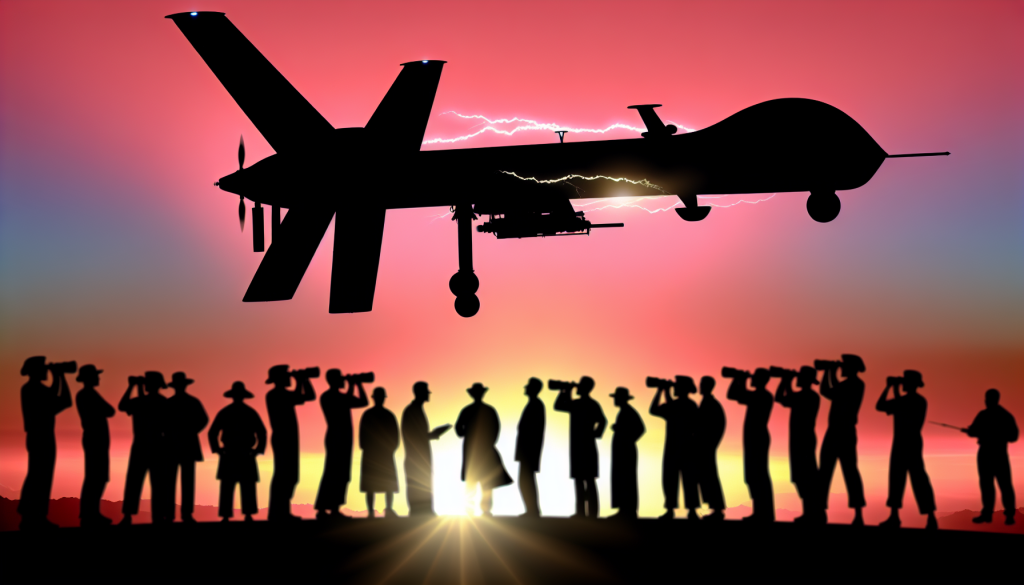Nuclear Bombs on Drones: The Next Arms Race that Has Experts ‘Very Concerned’
A new nuclear arms race might be brewing, spurred by Russia’s invasion of Ukraine—not with massive submarines or loud missiles, but with small, silent drones. This alarming potential was articulated by Ukrainian President Volodymyr Zelenskyy during his recent address at the United Nations General Assembly. He cautioned that it would be more cost-effective to halt Russian aggression now than to wait “to see who will be the first to create a simple drone carrying a nuclear warhead.” Zelenskyy emphasized the urgency: “We must use everything we have, together, to force the aggressor to stop,” warning that continued unchallenged aggression would only push the conflict to new extremes.
A ‘Potential’ New Arms Race
Experts are sounding the alarm that drones capable of carrying nuclear weapons could already be a reality. TASS, the Russian state-owned news agency, reported on a nuclear-armed underwater drone called Poseidon in 2023. Back in 2018, the U.S. defense ministry also acknowledged the development of a new intercontinental, nuclear-armed, nuclear-powered underwater drone by Russia. Mick Ryan, a retired Australian Army major general and a military studies fellow at the Lowy Institute, stated that the existence of drones with nuclear capabilities “may already be a reality.”
Concerns extend beyond Russia; China is also reportedly testing larger underwater drones in the South China Sea, which might be armed with nuclear weapons in the future. Ryan commented, “These systems could lead to a new nuclear arms race among nations seeking powerful nuclear delivery mechanisms.” He noted, “Arms races are constant and often go unnoticed, but they are happening daily.”
Almost ‘No Humans Involved’
As if nuclear arsenals on drones weren’t concerning enough, the potential for artificial intelligence (AI) to control these drones adds another layer of complexity. Zelenskyy again warned at the UN that it is only a matter of time before drones become fully autonomous, operated solely by AI, with minimal human involvement. Reports suggest Ukraine has already begun deploying AI-powered drones on the battlefield, using technology that allows groups of drones to make independent decisions.
While Ryan posited that AI could potentially reduce civilian casualties in warfare, he acknowledged the theoretical nature of that scenario. Conversely, increasing reliance on AI poses ethical questions, especially regarding life-and-death decisions delegated to machines. Australian Foreign Minister Penny Wong echoed this sentiment, urging world leaders to establish regulations to prevent machines from making such crucial decisions: “Decisions of life and death must never be delegated to machines.”
Changes in Warfare
Since Russia’s full-scale invasion of Ukraine in February 2022, the nature of warfare has evolved dramatically. The conflict has seen a skyrocketing rise in drone usage, with numbers reportedly growing from “a few thousand” to “millions.” In April, Vladimir Putin announced that Russia had produced over 1.5 million drones the previous year, with targets set between 3 and 5 million. Ukraine, too, is gearing up to produce approximately 4.5 million drones, which highlights the escalating significance of this technology in modern warfare.
Drones have transitioned from a niche tool to a pivotal element of combat strategy. Oleksandra Molloy, a drone warfare expert from the University of New South Wales, noted that drones have proven to be formidable weapons able to strike effectively from various distances, demonstrating a significant asymmetry in warfare capabilities.
Building Walls in the Sky
Drones pose risks that extend beyond traditional war zones, as evidenced by recent drone incursions reported across Europe. Danish Defense Minister Troels Lund Poulsen described these incidents as “systematic” hybrid attacks, although Russia has denied involvement. Molloy pointed out that this is not just a regional issue; it’s a global one that requires urgent attention.
In response, the European Union has announced its intention to develop a drone wall system for its eastern defenses, inspired by Ukraine’s successful integration of a similar system. This “drone wall” aims to detect and neutralize drone threats over specific distances, requiring substantial investment in technology and expertise. Molloy reflected on the critical need for these systems, emphasizing that “drones are the threat of today and will remain the threat of tomorrow.”
As nations grapple with these advancements, the call for vigilance and rapid adaptation to the evolving landscape of warfare is louder than ever. The fusion of nuclear capabilities and drone technology could radically change the dimensions of global conflict, with implications that will resonate for decades to come.

